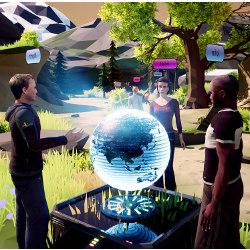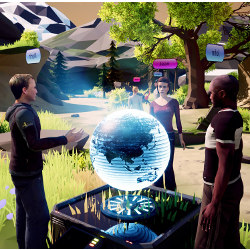
Trying to distill and describe what is being called the metaverse today is a bit like trying to describe the Internet to people in the 1970s or 1980s: the framework and building blocks were there, but few pundits were able to accurately encompass, delineate, and predict the applications that gained traction, the wide-ranging technological achievements that would occur, and how everyday life has been impacted via the commercial use of a worldwide network of computer servers.
What Is the Metaverse?
The metaverse has been described as a network of virtual worlds, where augmented reality (AR), virtual reality (VR), and the Internet come together to provide a fully immersive, three-dimensional (3D) experience to users. Technology stalwarts such as Meta (the company formerly known as Facebook) have gone on a public relations blitz to depict a world in which doctors might be able to practice operating in a VR world before ever using a scalpel on a patient, or where people can feel immersed in remote locations and experiencing the sights and sounds as if they were there, while sitting in their homes wearing VR googles and headsets.
Indeed, AR, VR, holographic technology, and high-speed, low-latency communication networks are typically described as the foundational elements of the metaverse. Yet the specifics of which use cases, applications, and companies will drive the development of the metaverse and thrive in its new ecosystems remains an open question.
“No one knows what the metaverse is right now, other than the fact that people are speculating heavily because they’re speculating on virtual property,” says Jennifer deWinter, a professor of arts, communications, and humanities at Worcester Polytechnic Institute (WPI) in Worcester, MA. “I think Face-book is imagining it as a 3D digital environment. If you expand it out into a bunch of tech entrepreneurs or futurists, it’s probably a grouping of applications still in and around the same idea of digitized selves.”
The idea of immersive, digital communities was around long before Facebook decided to rebrand and capitalize on the metaverse. Nearly 20 years ago, virtual communities that allowed people to connect with each other in an immersive, fully digital environment, such as Second Life and Habbo Hotel, sprung up and introduced the concept and use of “avatars,” digital representations of a real person depicted in a virtual environment. Not surprisingly, Hollywood got into the act as well, with movies such as the aptly named Avatar, as well as Jumanji, where children are sucked into the virtual world of the game itself and actually become their digital avatars.
The metaverse will require three elements in order to become as ubiquitous as the Internet itself: a robust communications infrastructure, powerful and easy-to-use development platforms and, perhaps most importantly, compelling applications that provide value to users that cannot be replicated or found elsewhere.
Building the Metaverse
The development and rollout of 5G and 6G communications networks will serve as the backbone for the metaverse, which will require fast, always-on, and rich data exchange among users, virtual worlds or environments, and applications. In particular, graphics-intensive technologies such as AR, VR, and holograms will not function optimally without robust, reliable communications networks.
The metaverse also will require platforms that allow content creators to develop the virtual worlds in which users will interact, as well as supporting the technologies that bring these digital worlds to life. Today, the most common platforms being used for metaverse VR platforms are Decentraland and Voxels, which are virtual-world, browser-based platforms where users can buy virtual plots of land in the platform as NFTs, but this will change as existing players enter this new space, explains Prashant Kelker, partner, digital strategy and solutions, for technology research and advisory firm ISG.
Kelker also observes that several large hyperscale companies (which have vast amounts of cloud-based compute, memory, networking, and storage resources) likely will support the initial infrastructure needed to support metaverse applications. For example, Kelker says Meta plans to develop a massive supercomputer to power the metaverse, and has selected the European Union to develop the metaverse technology in order to create more employment in Europe.
He also cites NVIDIA’s development of metaverse-ready assets known as Omniverse, Apple’s creation of a head-mounted display (HMD) virtual meeting application, and Unity Software’s efforts to supply a development platform that supports 3D, VR, and AR-based environments.
“The key element in my mind that needs to be solved is kickstarting a parallel market between creators and consumers,” says James Kaplan, co-founder and CEO of conversational AI company MeetKai. “There needs to be a major push from the entire ecosystem to make content easier to create.”
“When it comes to the early stages of the metaverse, gaming is the most easily identifiable utility. But beyond gaming, the metaverse is proving to be quite versatile.”
There also needs to be a balance between creative freedom within the metaverse and appropriate levels of content curation and regulation, according to deWinter. Unregulated virtual applications and worlds can become havens for hate speech, pornography, or other inappropriate content, which deWinter said have popped up in Second Life, as it didn’t feature strong-enough content moderation to keep out the undesirable elements.
“That’s a real trajectory of any of these massive online social media, without very careful regulation and even with careful regulation,” deWinter says, noting that virtual communities likely will become online civic spaces that need to be policed to be inclusive, in the same way real-world physical spaces do.
Entering the Mainstream
The development of compelling applications is the final key to broadening the appeal of the metaverse. Certainly, entertainment applications remain an attractive initial use case for deploying immersive virtual worlds.
“When it comes to the early stages of the metaverse, gaming is the most easily identifiable utility,” says Raj Koneru, CEO of Kore.ai, a conversational AI platform. “But beyond entertainment, the metaverse is proving to be quite versatile; fashion powerhouses like Balenciaga have plans to offer couture outfits for digital avatars, while fast food titans like McDonald’s have virtual restaurants where customers can actually order food for home delivery.”
One element that may help to spur adoption of metaverse-level apps among non-techies is the ability to accurately replace tasks or experiences they would have in real life with a digital experience, according to James Kaplan, co-founder and CEO of conversational AI company MeetKai.
“The easiest example is shopping: shopping in real life is fun because you are with others and can look at the same thing as others, look at what other people are liking, and ask questions,” Kaplan says, noting that “a metaverse shopping application would be able to provide the similar shopping experience as real life, except enhanced, because the store is virtual and can adjust in real time to each user.”
That said, WPI’s deWinter believes this view of the metaverse is rooted in the Western culture’s view of virtual worlds being somewhat limited to the economic and corporate possibilities. “When you move into the East, they imagine the metaverse pretty differently,” deWinter says. “This is where you see much more of an amalgamation of augmented reality. In Japan, South Korea, and China, they are beginning to imagine this future with highly augmented, physical realities that are married in or seamlessly integrated into digital spaces.”
deWinter points to teamLab, an interdisciplinary art collective that was formed in Tokyo, Japan, and has introduced certain elements of the metaverse into real-world experiences, such as at the group’s museum café.
“If you go to the Tokyo teamLab [museum’s] cafe, you can get a cup of tea,” deWinter says, noting that once the cup is placed on a table, a digital flower begins to grow on the cup of tea. Once the cup is lifted from the table, the virtual flower begins to fall apart and the digital petals fall and disperse, creating a melding of the real world with a digitally augmented virtual experience.
The use of a virtual environment as a stand-in for the real world is also seeing promise in mental health treatment. Amelia Virtual Care, a company that provides a VR-based environment that behavioral therapists can use with their patients to deal with phobias or other mental conditions, has created a tool that lets patients practice managing their phobias in a safe, fully controlled virtual environment, so they can be trained to respond or not respond to specific stimuli.
“Our solution is another tool to help professionals and patients deal with or address their issues,” explains Xavier Palomer, founder and executive chairman of Amelia Virtual Care. “It’s not a substitute for [professional therapy]—it’s a tool that is used in tandem with the traditional ways of approaching” mental health issues or phobias.
Palomer provides the example of how the environment can assist a child with Attention Deficit/Hyperactivity Disorder (ADHD). “We will put this child in a virtual classroom, and because of the sense of presence provided by the application, the kid believes that he or she is in a real classroom, not in a digital classroom,” Palomer says. “We start suggesting or stimulating the child with different distractions, and by doing that in a gradual way, in a progressive way, the child learns how to avoid these distractions and keeps their focus on the class.”
Palomer adds that the Amelia Virtual Care environment is only available for use under the care of a licensed mental health professional, and is compliant with the Health Insurance Portability and Accountability Act of 1996 (HIPAA). “If patients have concerns on privacy, therapists will avoid this [type of tool],” he says. “Mental healthcare has a huge social stigma attached to it, so we cannot put another barrier in place.”
Will There Be Multiple Metaverses?
For now, the metaverse is in its relative infancy, according to Prashant Kelker, partner, digital strategy and solutions, for technology research and advisory firm ISG. “The first B2C (business to consumer) trials and trends will emerge in retail, travel, entertainment, and hospitality,” Kelker says. “Wherever environments are more controlled and can be presented to a captive audience—for example, immersive experiences on a cruise ship or in a theme park—companies will seize the chance to go beyond AR/VR and create their own micro-communities of fans using NFTs.”
Market participants expect multiple metaverses may emerge organically, but any one of them may not be easily integrated or connect with others.
Indeed, the underlying vision of the metaverse appears to be around actual experiences, rather than a more passive approach to interaction. “Our take, and I have seen maybe one or two other companies looking at this too, is that the metaverse must be a place where you can actually do stuff,” Kaplan says.
Technology market participants expect multiple metaverses may emerge organically, but any one of them may not be easily integrated or connect with others. “The problem is that connectivity between metaverses is going to be close to impossible with how differently the underlying tech stack works,” Kaplan says. “Even companies working on connected avatars are running into huge issues in even just animating them in different worlds.”
However, Kaplan expects that eventually, “The real metaverse is going to be an evolved World Wide Web, which will live in your browser, and the connections between different metaverses [will be] no different than the connections between different Web pages, just links.”
Virtual Communities: Second Life Virtual Community: https://www.secondlife.com/
Habbo Hotel: https://www.habbo.com/
Decentraland: www.decentraland.org
Voxels: www.voxels.com
teamLab Artists Collective: https://www.teamlab.art/
Explainer: What is the metaverse? Reuters, https://www.youtube.com/watch?v=99BnZ8js1_k





Join the Discussion (0)
Become a Member or Sign In to Post a Comment